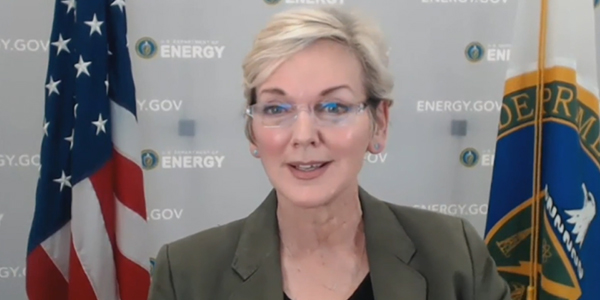Newly confirmed Energy Secretary Jennifer Granholm came to the Policy Forum of the American Council on Renewable Energy on Wednesday with the clear intent of firing up the troops — with announcements, insights on the challenges ahead and a mantra focused on action.
“No more waiting,” Granholm told the forum’s virtual audience. “Deploy, deploy, deploy.”
Her main message, echoing President Biden, was that beyond its very real existential threat, the climate crisis is a job and innovation generator, and the U.S. must be on the front lines, technologically and economically.
“The products that reduce carbon emissions are going to create a $23 trillion global market over the next decade,” Granholm said. “Where are those investments going to be [made]? Are they going to be in China? Are they going to be in our economic competitors? You better believe that they are strategizing now to corner this market. So, the question for us is: are we going to get in a battle, or are we going to bring a knife to a gunfight?”
The Department of Energy is first deploying research and development dollars, with $300 million in funding opportunities announced in the past month, to small businesses and clean tech entrepreneurs, workforce development and “one-of-a-kind ventures,” Granholm said. One example, DOE’s Frontier Observatory for Research on Geothermal Energy initiative, will fund “cutting-edge geothermal projects with the potential to power millions of American homes,” she said.
On the research front, Granholm pointed to DOE’s 17 “super powerful” national laboratories and their 70,000 scientists, engineers, researchers and analysts as key components for developing and testing the technologies needed to accelerate the U.S. energy transition.
“I am really thrilled to announce that our Pacific Northwest National Laboratory in Washington is kicking off the design and construction phase of the Grid Storage Launchpad,” she said. “It’s a $75 million research facility where we will be figuring out how to speed up the innovation and deployment of grid-scale technologies for energy storage, so we can get all of this new renewable power onto the system and make our national power grid more reliable, more resilient [and] more secure.”
Ramping up and reviving existing programs ― for example, recruiting clean tech investor Jigar Shah to head DOE’s $40 billion energy loan program ― is only a first step, Granholm said. “We look to work closely with the White House on its upcoming jobs and infrastructure package, which we hope is going to have a huge emphasis on opportunities in the renewable energy sector,” she said.
A new Office of Energy Jobs “is going to help us seize these jobs opportunities in all corners of the country, especially in places that have felt unseen, that have really been hurting, and get them first the benefits of these opportunities,” Granholm said.
Lowest-hanging Fruit
On the inevitable subject of Texas’ recent power outages, Granholm looked beyond the immediate need for grid hardening. Speaking with ACORE CEO Greg Wetstone, she said, “We have to figure out what’s the lowest-hanging fruit. Where are the clog [points] right now and the interconnects, and while we do the quick, low-hanging fruit, we need to plan for the future because we are going to see, especially with electrification of vehicles, a massive amount of need for new capacity on the grid.”
Biden’s Justice40 initiative to ensure that 40% of federal government investments benefit disadvantaged communities will take a “place-based” approach to address the different needs of environmental justice and fossil fuel communities, she said. What might work for coal communities in West Virginia and Appalachia “might not be good for Flint,” Granholm said. “You have to listen very carefully and have bottom-up strategies for these communities.”
Granholm’s closing remarks were similarly strategic. She called on clean energy groups like ACORE to double down on their lobbying and support activities for energy allies in Congress “to make it safe for them to be able to vote to make the investments that are necessary.”




